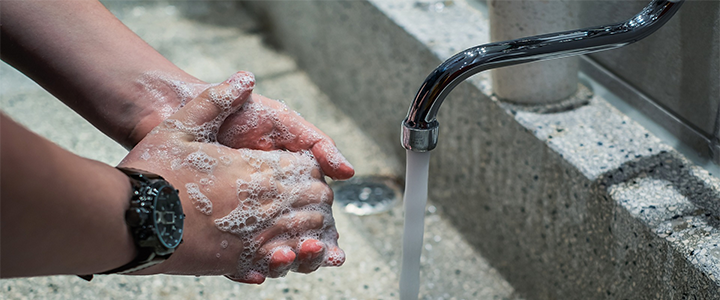
December 2022: Scrubbing Sustainably: Eco-Friendly Hygiene Habits
Hygiene habits are routine tasks that we complete without ever thinking about their environmental impact. While maintaining proper hygiene is important for human health, some hygiene habits and products can actually have negative consequences for the environment. However, there are some ways you can incorporate healthy hygiene practices into your routine so that both you and the environment can stay clean!
Conserve Water, Conserve Life
You probably hear about conserving water all the time but may wonder how much of an impact you can have by running the faucet a little less. Reducing your water usage truly is a critical step toward sustainability in hygiene habits. It helps protect ecosystems and can save on your energy usage. Energy is used to filter, heat and pump water every time you use it in your home. Think about the amount of energy – and emissions – that you could save by reducing your water consumption. There are many small steps that you can take in your hygiene routine to reduce your water consumption, including turning off the water while brushing your teeth, which saves 4 gallons water each time, and taking shorter showers. Taking the extra steps to reduce your water usage and conserve your water supply saves money and makes a difference toward sustainability in your hygiene habits.
Piles of Plastic
Plastic seems to be in practically every product on the shelf nowadays, and it’s true of our hygiene products, too. Plastic bottles and packaging can be found in shampoo, conditioner, face wash, body wash, hand soap, toothpaste and toothbrushes. While it’s important to recycle your plastic containers when you are able, many types of plastic are unable to be recycled or are difficult to recycle. At least 85% of plastic waste in the U.S. went to a landfill in 2021 alone, and plastic materials can take anywhere from 20 to 500 years to decompose, depending on the type of plastic.
Fortunately, there are plastic-free alternatives you can use to develop more eco-friendly habits. For example:
- Shampoo and conditioning bars. No plastic containers. Instead, they often come in cardboard packaging, which is easier to be recycled and is a better alternative to plastic.
- Soap bars can also be used to replace any hand soaps, face wash or body wash that come in plastic containers.
- Bamboo or cornstarch toothbrushes. Plastic toothbrushes cannot be recycled, so they ultimately end up in a landfill. To reduce your plastic waste, try switching to one of these plastic-free alternatives. There are also other alternatives to the plastic floss picks that work just as well for your hygiene needs, including cornstarch, biodegradable and refillable floss.
Is It Really ‘Natural’?
Aside from the packaging of products, the contents of products themselves can have ingredients that are harmful to your health and the environment. In addition, companies can also intentionally or unintentionally “greenwash,” which is the practice of misleading consumers by advertising products to be more sustainable than they actually are. With greenwashing, it can be difficult to determine what products are eco-friendly, so it’s important to pay attention to the ingredients in products. Here is a list of some ingredients to stay away from:
- Polypropylene and Acrylate Copolymer (Microbeads): Found in some exfoliating skin care products, these tiny plastic beads can go down the drain and contaminate groundwater. Microbeads are banned in the U.S., but some products disguise microbeads in products by listing it as “polypropylene” and “acrylate copolymer.”
- Oxybenzone (BP3) and Octinoxate (EMHC): These UV filter ingredients are found in many sunscreens and personal care products. Oxybenzone and octinoxate are two of the most common ingredients that can damage coral reefs, along with aquatic life and other habitats, by affecting their ability to defend against bleaching, damaging their DNA and harming their development and causing death. Sunscreen and other skin care products can also have small doses of benzene, which can be very dangerous and detrimental for your health.
- Sulfates: Sulfates, which are in some toothpastes, shampoos and other products, can actually pollute water sources and be harmful to aquatic life. Sulfates contribute to acid rain, which damages surface water and ecosystems.
Being aware of these ingredients that can be found in hygiene products, among others, can help improve the health of you and the environment. When in doubt, trustworthy certifications can also help verify an eco-friendly product, such as a USDA Organic or Fairtrade certification. However, beware of misleading labels that don’t have a certified backing. You can also search for any ingredients, brands or products you’re unsure about on trusted environmental search engines, like Environmental Working Group’s Skin Deep database, as well as information related to bug repellent, cosmetics and sunscreen. By taking the extra time to look over the ingredients of a product before purchasing, you can greatly reduce your environmental impact.
Small Steps to Success
It can be overwhelming to see that there’s so much to do to help protect the environment, but taking small and manageable steps toward sustainability helps create lasting patterns that benefit environmental efforts. Maybe you start by changing your toothbrush next time you have to buy one or by switching to shampoo bars. Any of these smaller steps can make a difference and help to spread awareness about our environmental impact.




